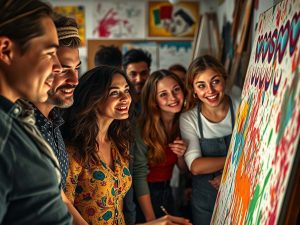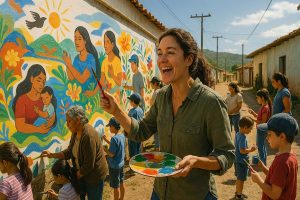
How State-to-State Collaboration Among Art Councils Expands the Reach of Creative Communities
Art isn’t confined by geography. While local initiatives remain valuable, there’s growing recognition that working across state lines can unlock far more opportunities. In the United States, more and more art councils are choosing collaboration over isolation—sharing ideas, resources, and creative energy to reach wider audiences and empower more artists.
This kind of teamwork goes beyond sharing gallery space or event calendars. The real purpose is to strengthen and diversify artistic communities across regions. When creative groups from different places come together, they spark innovation, amplify voices, and create stronger cultural networks that are inclusive and far-reaching.
– Art councils across states are increasingly working together to build broader support for the arts.
– Collaborations open access to grants, exhibitions, and artist residencies that may not be available locally.
– These efforts encourage cultural exchange and provide a stronger platform for diverse artistic voices.
Why Partnering Across State Lines Makes a Big Difference
Art has always been fluid. Ideas travel freely, regardless of zip codes. That’s what makes partnerships between art councils in different states so powerful. These efforts not only give more artists a stage but also connect them with new communities that might otherwise remain out of reach.
This type of collaboration brings new conversations to the table. A rural art council might have different priorities from one in a bustling city, but when they work together, they build programs that reflect a more complete picture of society’s needs. That exchange of perspectives leads to richer, more balanced projects.
It also makes representation stronger. Working with groups from different regions brings varied forms of expression into the spotlight. It’s not just about mainstream styles—it’s about making room for traditional, experimental, and Indigenous voices too. The result? A more inclusive experience for artists and audiences alike.
Benefits That Come With Working Together
When art councils join forces, their communities gain access to a broader range of opportunities and resources. These advantages are not only practical but also transformational in building strong networks for the long term.
Some Key Benefits Include:
- More opportunities for artists: A painter based in Michigan might get the chance to exhibit work in Wisconsin through a joint event. It’s not just about visibility—connections made through collaborative projects often lead to mentorships, residencies, or even representation in galleries they wouldn’t reach otherwise.
- Learning from each other’s experiences: Every council has its own way of doing things. By sharing practices through forums, training programs, or informal meetings, councils improve their support systems and make better decisions for their artists and communities.
- Greater access to funding: Some grants prioritize or even require collaborative proposals. When councils pool resources, they’re more likely to qualify for national-level support. Their combined credibility also helps them make a stronger case for arts funding in broader social and political spaces.
- Expanded audience reach: Events that are streamed online or promoted jointly across states gain more traction. A local artist can gain exposure outside their home base, and councils can showcase their region’s talent to wider, more diverse audiences.
Real Examples That Show the Impact
A great example of this type of collaboration happened between the art councils of Duluth, Minnesota, and Superior, Wisconsin. The two towns are only separated by a bridge, yet they belong to different states. When their councils teamed up for a two-week art walk, the outcome was more than just a series of gallery visits.
During that time, foot traffic in participating galleries rose by nearly 40%. Local businesses like coffee shops and bookstores also saw a boost in customers. Artists made meaningful connections through networking events tied to the walk, leading to new collaborations and opportunities.
Some of the participating artists even received invitations to show their work in galleries in other states. A few were later featured in national art publications, proving that a single project can spark wide-reaching recognition and growth. Events like these also build public trust in arts institutions and reinforce their value to society.
Simple Ways Art Councils Collaborate
Working together doesn’t always mean launching a big production. Many councils begin with smaller, more manageable projects that pave the way for deeper partnerships. Here are some common ways they do that:
Small Projects with Big Potential
- Joint workshops: Whether virtual or in-person, shared workshops cover everything from painting techniques to discussions around social themes like mental health or environmental issues. These sessions often provide inspiration and advocacy training for artists.
- Shared artist residencies: Some programs allow artists to spend time creating in one state, then move to another for a fresh experience. These residencies give artists time, space, and new perspectives that influence their work and build their confidence.
- Co-curated exhibits: Curators from different councils team up to design a single show, blending multiple styles and themes. This not only challenges artistic boundaries but also creates more dynamic, well-rounded presentations for audiences.
- Digital portfolio events: For artists who can’t travel, councils offer online platforms where they can present their work. Virtual gallery tours, artist talks, and real-time Q&A sessions create ways for them to connect with wider markets and potential patrons.
The Role of Local Communities
None of this works without community support. Residents, schools, businesses, and local governments play a major role in making joint art projects successful.
Coffee shops might host exhibits. Parks may serve as venues for outdoor performances. Families attend with their kids, turning events into family outings. Schools sometimes tie exhibitions into their field trips or arts curriculum. Seniors get to share stories and cultural insights, enriching the experience for everyone involved.
Community members also support in other ways—donating, volunteering, or helping spread the word. Their involvement adds meaning and momentum that can’t be bought with grant money alone.
When people see art as something that’s part of everyday life, they become more invested in keeping it alive and accessible. They recognize its power to connect, reflect, and strengthen the bonds that hold communities together.
Common Challenges and How Councils Manage Them
Naturally, partnerships come with challenges. Some of the common ones include:
- Budget differences between councils
- Conflicting timelines or goals
- Time-intensive planning and coordination
- Limited access to technology for online events
Artists may also feel nervous about stepping into unfamiliar settings. Adjusting to a new culture or language can be overwhelming. That’s why many councils provide orientation programs and ongoing support to help everyone feel included and prepared.
Some have gone a step further by forming dedicated committees to troubleshoot and streamline inter-council projects. These teams address issues as they come up, ensuring smoother collaborations in the future.
Looking Ahead
When councils reach beyond their borders, the impact goes far beyond just the arts. They build bridges—between people, cultures, and ideas. The message is clear: distance doesn’t have to be a barrier. When the goal is unity and growth, creative communities thrive.
Art has always been a reflection of our humanity. When it’s nurtured together, it becomes more powerful. Connection is something we all crave, and through the arts, we find a path toward it.
Now may be the perfect time for councils in Sault Ste. Marie and nearby regions to consider cross-border partnerships of their own. Doing so would give more artists a voice—and bring the heart of local art even closer to the people it seeks to inspire.

